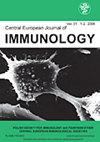Association of human leukocyte antigen class II alleles with epithelial cell apoptosis and extracellular matrix production in acute COVID-19
IF 1.6
4区 医学
Q4 IMMUNOLOGY
引用次数: 0
Abstract
Introduction:Pathogenic mechanisms and long-term consequences of COVID-19 require attention in studies on SARS-CoV-2. The association of the severity of COVID-19 with genetic factors, such as human leukocyte antigen (HLA) genes, remains underexplored. Our study assessed the relationships between HLA class II alleles and COVID-19 severity and blood-based indicators of systemic inflammation and organ damage, serum markers of epithelial cell apoptosis such as caspase-cleaved CK18 fragment M30 (CK18-M30) and the extracellular matrix product hyaluronic acid (HA).
Material and methods:
The study included 101 hospitalized COVID-19 patients (mean age 60 ±14 years). Clinical tests were performed at admission to the hospital. The levels of CK18-M30 and HA were detected in serum by enzyme-linked immunosorbent assay (ELISA). HLA typing was performed in HLA-DRB1, -DQA1, and -DQB1 loci by the polymerase chain reaction with low-resolution sequence-specific primers.
Results:
Sixty-one patients had a non-severe and 40 had a severe or critical disease course (following the WHO definition). The severity was associated with older age, male gender, higher HA, CK18-M30, and some indicators of inflammation. Despite the lack of direct association between HLA alleles and the severity of COVID-19, the presence of HLA-DRB1*04 and 12 alleles in the genotype was associated with lowered or elevated HA, respectively. The HLA-DQB1*03:01 allele was associated with lowered CK18-M30, aspartate aminotransferase, and ferritin. In addition, HLA-DQB1*06:01 was associated with elevated alanine aminotransferase.
Conclusions:
Associations of HLA class II alleles with markers of epithelial cell apoptosis and extracellular matrix production indirectly support the influence of HLA genes on acute COVID-19 severity.
人类白细胞抗原 II 类等位基因与急性 COVID-19 上皮细胞凋亡和细胞外基质生成的关系
导言:在对 SARS-CoV-2 进行研究时,需要关注 COVID-19 的致病机制和长期后果。COVID-19的严重程度与遗传因素(如人类白细胞抗原(HLA)基因)之间的关系仍未得到充分探讨。我们的研究评估了HLA II类等位基因与COVID-19严重程度之间的关系,以及基于血液的全身炎症和器官损伤指标、上皮细胞凋亡血清标志物(如Caspase裂解的CK18片段M30(CK18-M30)和细胞外基质产物透明质酸(HA))之间的关系。入院时进行了临床检测。通过酶联免疫吸附试验(ELISA)检测血清中 CK18-M30 和 HA 的水平。结果:61 名患者的病程不严重,40 名患者的病程严重或危重(根据世界卫生组织的定义)。严重程度与年龄、性别、较高的 HA、CK18-M30 和一些炎症指标有关。尽管 HLA 等位基因与 COVID-19 的严重程度没有直接联系,但基因型中存在 HLA-DRB1*04 和 12 等位基因分别与 HA 降低或升高有关。HLA-DQB1*03:01等位基因与CK18-M30、天冬氨酸氨基转移酶和铁蛋白的降低有关。结论:HLA II类等位基因与上皮细胞凋亡和细胞外基质生成标记物的相关性间接支持了HLA基因对急性COVID-19严重程度的影响。
本文章由计算机程序翻译,如有差异,请以英文原文为准。
求助全文
约1分钟内获得全文
求助全文
来源期刊

Central European Journal of Immunology
IMMUNOLOGY-
CiteScore
3.00
自引率
0.00%
发文量
17
审稿时长
6-12 weeks
期刊介绍:
Central European Journal of Immunology is a English-language quarterly aimed mainly at immunologists.
 求助内容:
求助内容: 应助结果提醒方式:
应助结果提醒方式:


